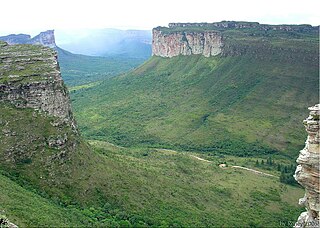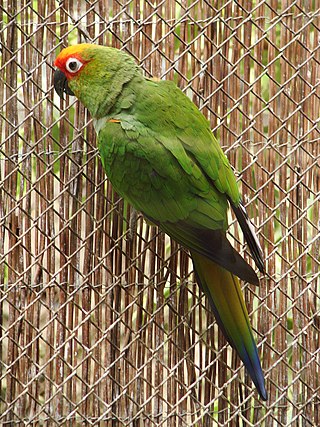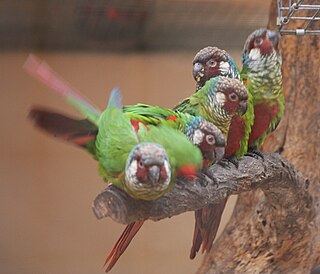
The Chapada Diamantina National Park is a national park in the Chapada Diamantina region of the State of Bahia, Brazil. The terrain is rugged, and mainly covered by flora of the Caatinga biome.

The maroon-bellied parakeet is a small parrot found from southeastern Brazil to north-eastern Argentina, including eastern Paraguay and Uruguay. It is also known as the reddish-bellied parakeet, and in aviculture it is usually referred to as the maroon-bellied conure, reddish-bellied conure or brown-eared conure.

The red-browed amazon is a species of parrot in the family Psittacidae. It is endemic to Atlantic Forest in eastern Brazil. It has been considered a subspecies of the blue-cheeked amazon, but today all major authorities consider them separate species. It is threatened both by habitat loss and by being captured for the trade in wild parrots.

The golden-capped parakeet is a species of parrot in the family Psittacidae found in Brazil and Paraguay. Its natural habitats are subtropical or tropical dry forest, subtropical or tropical moist lowland forest, dry savanna, and plantations. It is threatened by habitat loss. The A. auricapillus is a good biological indicator because of its vulnerability, high detectability as well as its sensitivity to forest fragmentation.

The fiery-shouldered parakeet, also known as the fiery-shouldered conure, is a species of parrot in the family Psittacidae. It is found in Brazil, Guyana, and Venezuela. Its natural habitat is subtropical or tropical moist montane forests. There are two subspecies, P. e. egregia and P. e. obscura.

The crimson-bellied parakeet, known as the crimson-bellied conure in aviculture, is a species of bird in subfamily Arinae of the family Psittacidae, the African and New World parrots. It is found in Bolivia and Brazil.

The painted parakeet, known as the painted conure in aviculture, is a species of bird in subfamily Arinae of the family Psittacidae, the African and New World parrots. It is found in Brazil, Colombia, French Guiana, Guyana, Panama, Suriname, and Venezuela.

The grey-breasted parakeet is an Endangered species of bird in subfamily Arinae of the family Psittacidae, the African and New World parrots. Long thought to be endemic to Ceará in northeastern Brazil, it has also been documented in Bahia.

The white-eared parakeet or maroon-faced parakeet is a Vulnerable species of bird in subfamily Arinae of the family Psittacidae, the African and New World parrots. It is endemic to Brazil.

The Bahia coastal forests are a tropical moist broadleaf forest ecoregion of eastern Brazil, part of the larger Atlantic Forest region.

Una Biological Reserve is a Biological reserve in Brazil.
Córrego do Veado Biological Reserve is a biological reserve in the municipality of Pinheiros, Espírito Santo, Brazil.

Sooretama Biological Reserve (Portuguese: Reserva Biológica de Sooretama is a biological reserve in the state of Espírito Santo, Brazil.
Córrego Grande Biological Reserve is a biological reserve spanning the boundary of Bahia and Espírito Santo, Brazil.

Monte Pascoal National Park is a national park in the state of Bahia, Brazil.

The Rio Preto National Forest is a national forest in the state of Espírito Santo, Brazil.

The Descobrimento National Park is a national park in the state of Bahia, Brazil.

The Serra do Conduru State Park is a state park in the state of Bahia, Brazil. It protects an area of Atlantic Forest that is regenerating after damage from human intervention.

The Mata Escura Biological Reserve is a biological reserve in the state of Minas Gerais, Brazil. It protects a remnant of Atlantic Forest, and includes a unique mix of vegetation on sandy hilltops. The reserve overlaps with a traditional quilombo community, creating a conflict with the reserve's full-protected status.
Álvaro Coutinho Aguirre was a Brazilian agronomist, zoologist and naturalist. Aguirre created the first reserve park for wild animals in Brazil, the Sooretama Biological Reserve at the state of Espírito Santo (the first protected area created in Brazil was in 1937. He dedicated his life to the preservation of the Brazilian flora and fauna, especially the Atlantic Forest and the biggest primate of the Americas, the Muriqui. During the 1960s, he undertook many expeditions to study the life and habits of the Muriqui and its conditions at the time. The results showed a considerable reduction of the groups of the animals, due to deforestation and lack of preservation of their habitat.


















